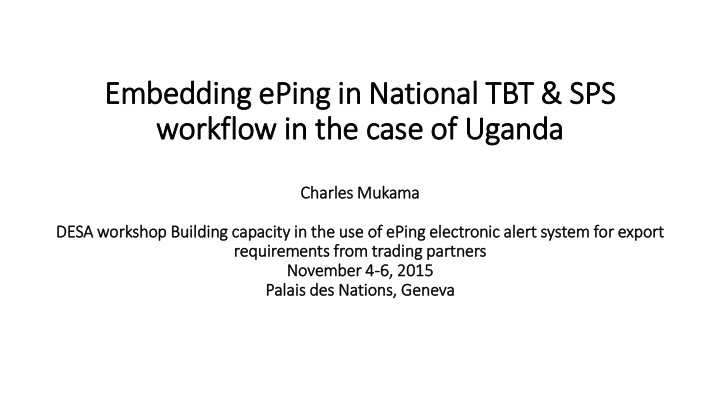



Embedding ePing in National TBT & SPS workflow in the case of f Uganda Char arles Mukama DESA wor DE orkshop Build ildin ing cap apacity in in th the use se of of ePin ing ele lectronic ale alert system for or export requirements fr from tr tradin ing par artners November 4-6, 6, 20 2015 15 Pala alais is des s Nations, Ge Geneva
SPS Enquiry Point in Uganda • The SPS EP is housed in the Ministry of Agriculture, Animal Industry and Fisheries, MAAIF – 3 sub components • Currently notifications are accessed on a SPS web portal developed with facilitation from Trade Mark East Africa – www.maaifsps.org • Users can also register and get alerts on email and sms, • The EP is at the maned by one person from the dept of crop protection, • Coordination with livestock and fisheries is limited. • Limitations: • Can register notifications for fisheries, coffee and fruits & vegetables • Notifications from seven continents • Few fields and filters • Does not give options to access TBT
Introduction of ePing Notification System • The first phase of ePing NS was introduced in July 7 th -10 th 2015 • Participants from various MDAs • Structure to support the SPS EP was proposed: A) Public Sector • SPS Team leader, • Focal points: Crop SC, Livestock and Fisheries B) Private sector/Associations • Focal points: Horticulture, Fisheries, Flowers, livestock c) Regulatory agencies? • Work plans for the implementation were developed • The system was appraised- additional applications proposed.
SPS Experience with ePing • The on set impression, platform is user friendly with a number of filters or fields to choose from, • The public SPS team leader and focal points registered. • Registration is easy and notifications have since been received on a regular basis on emails based on the filters requested. • More applications have since been proposed to be added such as social media, bulk dissemination, exporting to Microsoft applications, • However, the structure has not been developed so no structured system for dissemination and collection of information is in place. • The concept for the implementation of the ePing NS at the SPS EP has been developed
Need for additional resources • There is more needed than just alert messages on portal > might be a white elephant • Development and building capacity of operational SPS structure (public and private) There is need for the whole information loop – dissemination and picking of information back to the notification point, • Harmonization of available notification systems, • Inventory and notification of all regulations, • Sensitization of stake holders along commodity value chain including decision makers for sustainability, • Alignment of laws to WTO regulations – access to public information. • Development of robust bankable projects for resource mobilization.
Initiatives in place • SPS/TBT Committee – platform for receiving and dissemination of SPS/TBT information, • Quality Infrastructure and Standards Program (QUISP) and the Mentorship Program both funded by SIDA • Trade Mark East Africa facilitating SPS notification alerts in MAAIF
Institutions SPS mandate Ministry of Trade, industry and Cooperatives National Notification Authority 1) National SPS Policy and advisor to the business community on Ministry Agriculture, Animal Industry and Fisheries; 1) SPS market requirements, Measures related to Animal, Fish and Plant health and food safety and National SPS Enquiry Point 1) Uganda Export Promotion Board 1) Uganda Coffee Development Authority SPS requirements for coffee 1) Diary Development Authority SPS requirements for diary 1) Ministry of Health Health and food safety 1) National Animal Genetic Resources Centre and Data Bank SPS Data for Animals 1) National Water and Sewerage Corporation Water and Environment safety 1) Uganda Government National Analytical Laboratory Testing of contaminants 1) Uganda Environment Management Authority Environment safety requirements 1) Uganda National Agriculture Chemicals Board Agro-chemicals 1) National Forestry Authority Safety of forest products 1) Ministry of Water and Environment Safety of water and environment 1) Uganda Food and Nutrition Council Nutrition and hygiene 1) Cotton Development Organization SPS requirements for cotton 1) Ministry of Works and Transport Safe transport of animals, plant and fish 1) Uganda Trypanosomiasis Control Council Vector control and quarantine issues 1) National Agriculture Research Organization Research on good agricultural products 1) Ministry of East African Community Affairs EAC Regional SPS Policy 1) National Drug Authority Safe of drugs and chemicals
Lessons learned • The SPS/TBT aspects are multidisciplinary – need for structure • The SPS/TBT information is a business tool and it is needed at real time – operation of the NS needs dedicated personnel. • The SPS and TBT aspects are linked sometimes with thin line- needs coordinated implementation, • Need for mainstreaming the SPS/TBT NS in the national plans and budgets for sustainability.
THANK YOU
Recommend
More recommend